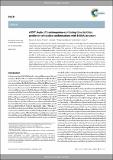A DFT study of 2-aminopurine-containing dinucleotides: prediction of stacked conformations with B-DNA structure
Date
07/06/2016Metadata
Show full item recordAbstract
The fluorescence properties of dinucleotides incorporating 2-aminopurine (2AP) suggest that the simplest oligonucleotides adopt conformations similar to those found in duplex DNA. However, there is a lack of structural data for these systems. We report a density functional theory (DFT) study of the structures of 2AP-containing dinucleotides (deoxydinucleoside monophosphates), including full geometry optimisation of the sugar-phosphate backbone. Our DFT calculations employ the M06-2X functional for reliable treatment of dispersion interactions and include implicit aqueous solvation. Dinucleotides with 2AP in the 5’-position and each of the natural bases in the 3’-position are examined, together with the analogous 5’- adenine-containing systems. Computed structures are compared in detail with typical B-DNA base-step parameters, backbone torsional angles and sugar pucker, derived from crystallographic data. We find that 2AP-containing dinucleotides adopt structures that closely conform to B-DNA in all characteristic parameters. The structures of 2AP-containing dinucleotides closely resemble those of their adenine-containing counterparts, demonstrating the fidelity of 2AP as a mimic of the natural base. As a first step towards exploring the conformational heterogeneity of dinucleotides, we also characterise an imperfectly stacked conformation and one in which the bases are completely unstacked.
Citation
Smith , D , Holroyd , L F , van Mourik , T & Jones , A 2016 , ' A DFT study of 2-aminopurine-containing dinucleotides: prediction of stacked conformations with B-DNA structure ' , Physical Chemistry Chemical Physics , vol. 18 , no. 21 , pp. 14691-14700 . https://doi.org/10.1039/C5CP07816D
Publication
Physical Chemistry Chemical Physics
Status
Peer reviewed
ISSN
1463-9076Type
Journal article
Description
This work was supported by studentship funding from the Engineering and Physical Sciences Research Council Doctoral Training Account to DAS and LFH (EP/K503162/1); EaStCHEM, University of Edinburgh and University of St Andrews; University of Melbourne.Collections
Items in the St Andrews Research Repository are protected by copyright, with all rights reserved, unless otherwise indicated.

